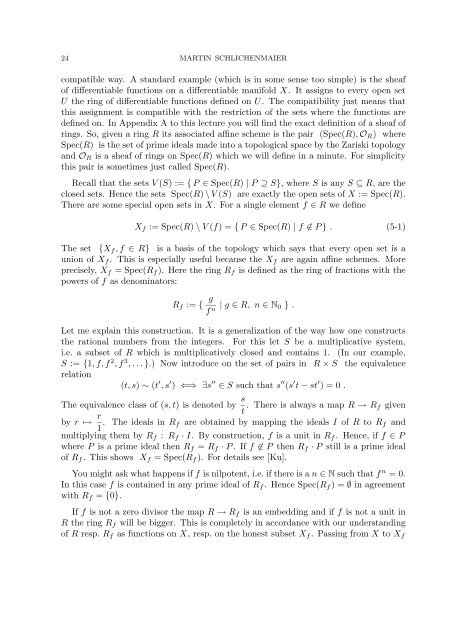Mannheimer Manuskripte 177 gk-mp-9403/3 SOME CONCEPTS OF ...
Mannheimer Manuskripte 177 gk-mp-9403/3 SOME CONCEPTS OF ...
Mannheimer Manuskripte 177 gk-mp-9403/3 SOME CONCEPTS OF ...
- No tags were found...
You also want an ePaper? Increase the reach of your titles
YUMPU automatically turns print PDFs into web optimized ePapers that Google loves.
24 MARTIN SCHLICHENMAIERco<strong>mp</strong>atible way. A standard exa<strong>mp</strong>le (which is in some sense too si<strong>mp</strong>le) is the sheafof differentiable functions on a differentiable manifold X. It assigns to every open setU the ring of differentiable functions defined on U. The co<strong>mp</strong>atibility just means thatthis assignment is co<strong>mp</strong>atible with the restriction of the sets where the functions aredefined on. In Appendix A to this lecture you will find the exact definition of a sheaf ofrings. So, given a ring R its associated affine scheme is the pair (Spec(R), O R ) whereSpec(R) is the set of prime ideals made into a topological space by the Zariski topologyand O R is a sheaf of rings on Spec(R) which we will define in a minute. For si<strong>mp</strong>licitythis pair is sometimes just called Spec(R).Recall that the sets V (S) := {P ∈ Spec(R) | P ⊇ S}, where S is any S ⊆ R, are theclosed sets. Hence the sets Spec(R) \V (S) are exactly the open sets of X := Spec(R).There are some special open sets in X. For a single element f ∈ R we defineX f := Spec(R) \ V (f) = {P ∈ Spec(R) | f ∉ P } . (5-1)The set {X f ,f ∈ R} is a basis of the topology which says that every open set is aunion of X f . This is especially useful because the X f are again affine schemes. Moreprecisely, X f = Spec(R f ). Here the ring R f is defined as the ring of fractions with thepowers of f as denominators:R f := { gf n | g ∈ R, n ∈ N 0 } .Let me explain this construction. It is a generalization of the way how one constructsthe rational numbers from the integers. For this let S be a multiplicative system,i.e. a subset of R which is multiplicatively closed and contains 1. (In our exa<strong>mp</strong>le,S := {1,f,f 2 ,f 3 ,...}.) Now introduce on the set of pairs in R × S the equivalencerelation(t,s) ∼ (t ′ ,s ′ ) ⇐⇒ ∃s ′′ ∈ S such that s ′′ (s ′ t − st ′ ) = 0 .The equivalence class of (s,t) is denoted by s t . There is always a map R → R f givenby r ↦→ r 1 . The ideals in R f are obtained by mapping the ideals I of R to R f andmultiplying them by R f : R f · I. By construction, f is a unit in R f . Hence, if f ∈ Pwhere P is a prime ideal then R f = R f · P. If f ∉ P then R f · P still is a prime idealof R f . This shows X f = Spec(R f ). For details see [Ku].You might ask what happens if f is nilpotent, i.e. if there is a n ∈ N such that f n = 0.In this case f is contained in any prime ideal of R f . Hence Spec(R f ) = ∅ in agreementwith R f = {0}.If f is not a zero divisor the map R → R f is an embedding and if f is not a unit inR the ring R f will be bigger. This is co<strong>mp</strong>letely in accordance with our understandingof R resp. R f as functions on X, resp. on the honest subset X f . Passing from X to X f
















